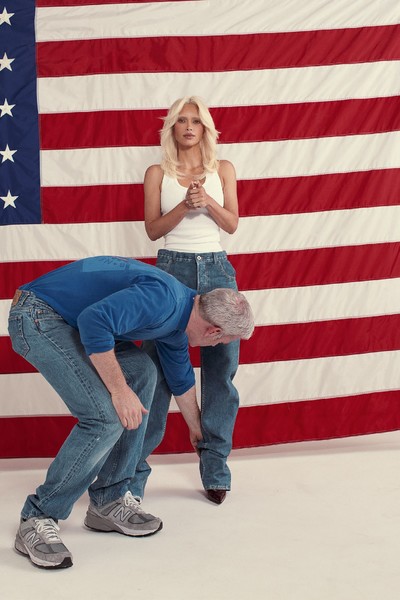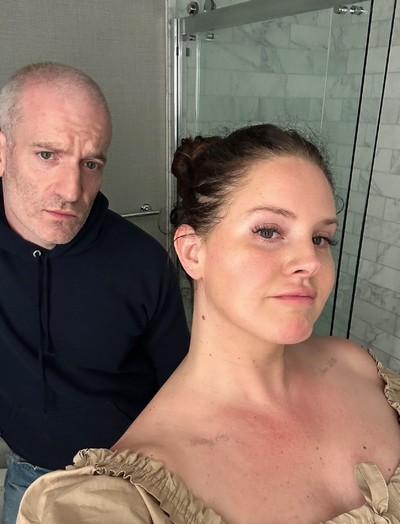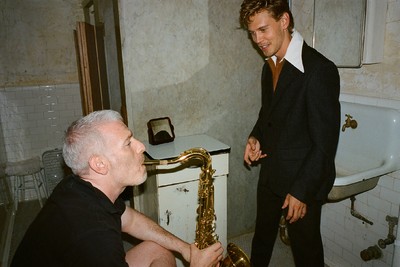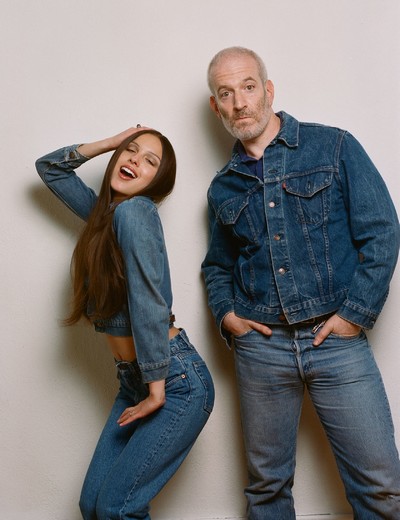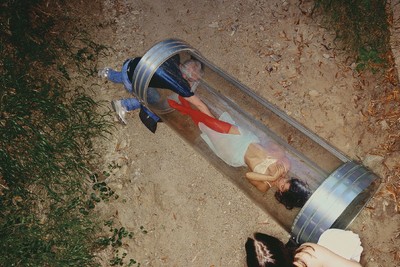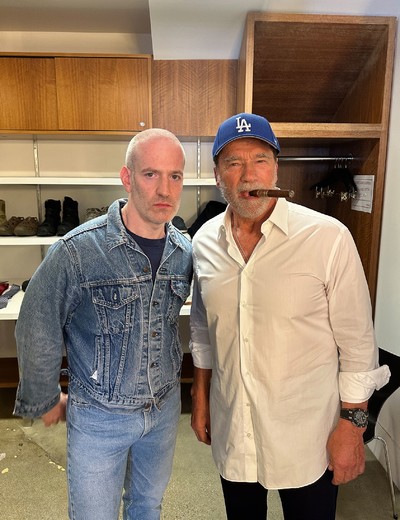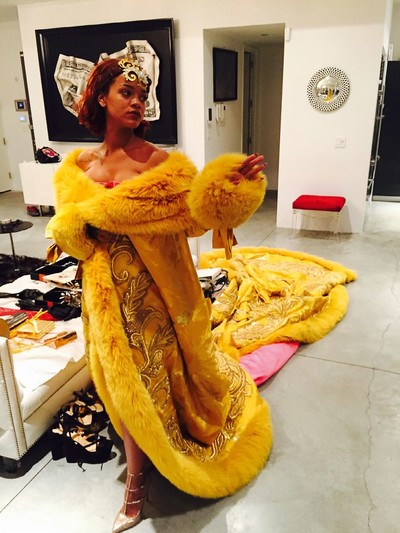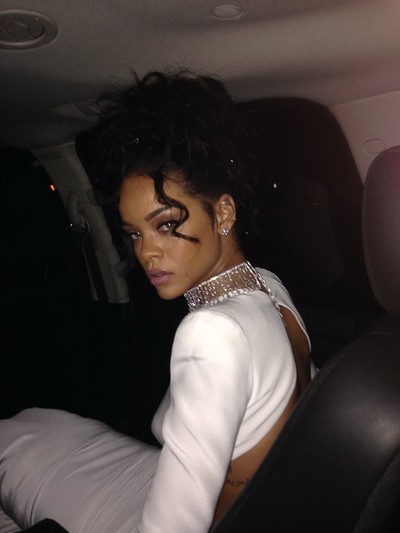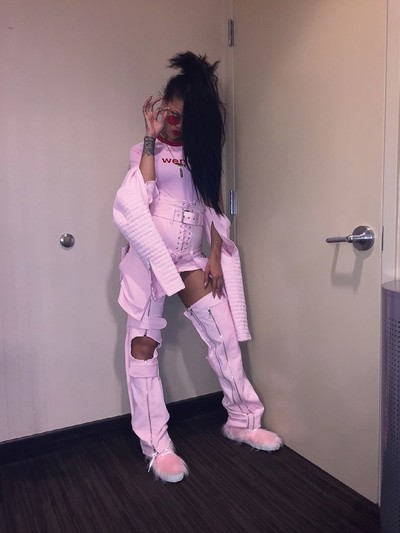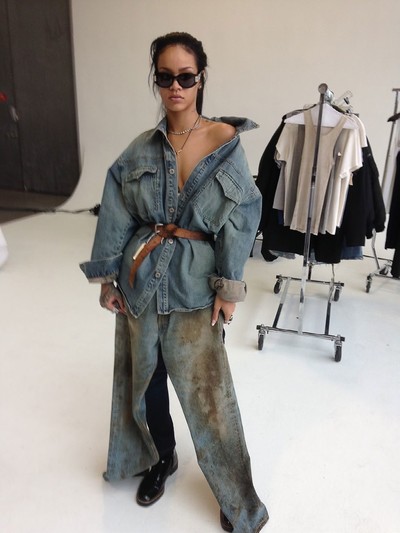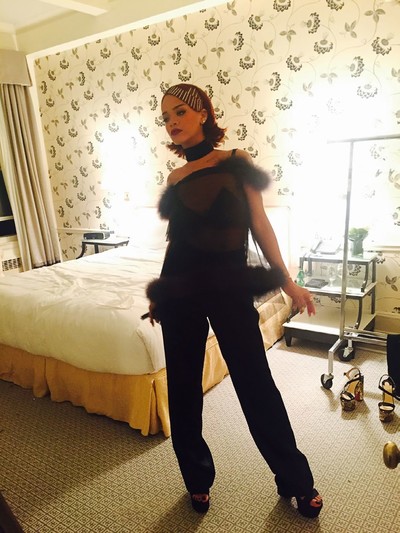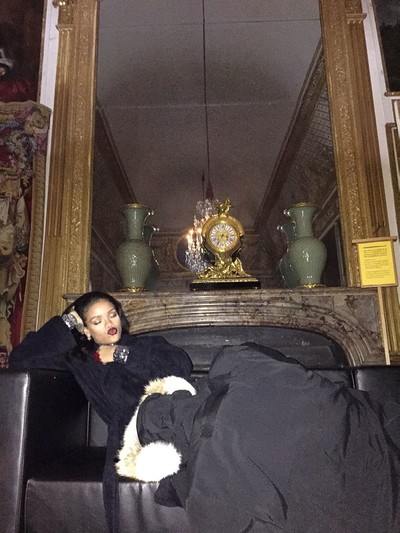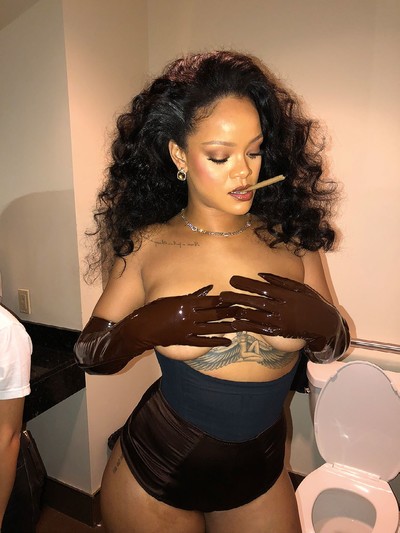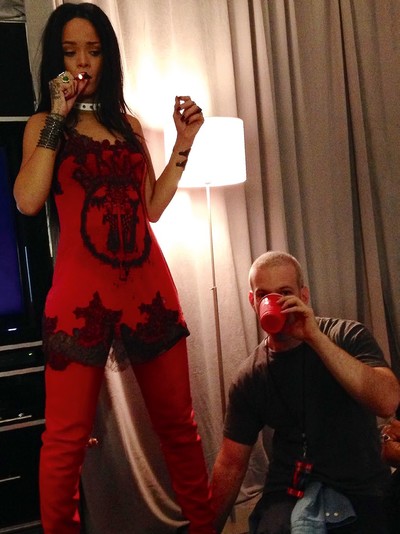For Interview’s editor-in-chief Mel Ottenberg, celebrities – both A-listers and ‘niche maniacs on the internet’ – are his medium.
Interview by Jonathan Wingfield
Portrait by Heji Shin

For Interview’s editor-in-chief Mel Ottenberg, celebrities – both A-listers and ‘niche maniacs on the internet’ – are his medium.
Mel Ottenberg was born to edit Interview magazine. Since his appointment in 2021, he has injected a much-needed double-shot of Warholian sass and downtown attitude into the title’s bi-monthly print edition and digital platforms. With the mood of the mag now pitched somewhere between #obsessed and droll whatever-ness, it seems that every major celebrity is queuing up for their cover shoot (routinely styled by Ottenberg himself). Kim Kardashian? Tick: ‘In a jockstrap, with her butt out, in front of the American flag.’ Lana Del Rey? Tick: cigarette dangling out of her mouth, and interviewed by Billie Eilish. Austin Butler? Photographed taking a shower and vacuuming John Giorno’s untouched loft on the Bowery (‘I mean, what could be more Interview?’). Delve inside the pages of any issue and you’ll find a veritable roll-call of TikTok stars, fly-by-nights, freaks, chancers, and old-timers. It’s a heady high-and-low party. It’s Interview at its scrappy best.
Ottenberg’s storied career in publishing and fashion reads like the perfect résumé for the gig. Emerging as an editorial stylist in early 2000s lower Manhattan, his signature off-kilter sexy aesthetic offered a subversive, self-aware take on a mainstream culture in which everyone, including the subject, was in on the absurdity of modern-day celebrity. Ottenberg quickly earned a roster of high-profile clients including Rihanna, Barbra Streisand, and Justin Bieber. In 2018, after having cast his all-American eye over European subculture at 032c magazine, where he had been fashion director since 2013, Ottenberg was appointed creative director of Interview. The magazine was being reborn from the ashes of a particularly catty (and public) legal demise, and Ottenberg became a new figurehead for a new chapter for a new era.
As with any great media venture in tune with the zeitgeist, Interview’s current success is partly down to its deft understanding of the technology of the times. ‘It’s no coincidence that Interview came out at the same time [1969] as the small cassette recorder,’ the title’s circa-1970s editor Glenn O’Brien, once explained. Fifty years on, Ottenberg’s version of Interview is a perfectly frenetic reflection of the technology driving social mobility today, chiefly TikTok’s blink-and-you-miss-it, everyone’s-a-star infinite scroll. In fact, Ottenberg’s own social-media activity perhaps best encapsulates the essence of what makes the new Interview so essentially Interview: on-set selfies with his A-list cover stars; playing Pac-Man at Corey Feldman’s in Hollywood; learning Italian with La Cicciolina in Milan; quizzing A$AP Rocky on his room-service habits while sitting front row at Gucci; asking his own 99-year-old grandma, Shirley, her opinion of Interview (‘nasty’); and handing out copies of the (sold out and super in-demand) Lana Del Rey cover-story issue to adoring fans in Washington Square Park.
System recently caught up with Ottenberg in (where else?) his local Sixth Avenue diner. Clad in his signature uniform of double-denim, aviator jacket and dad sneakers, he discussed the legacy of Warhol, his particular take on what brands want from celebrities, and why Hollywood is such a scary place.
Jonathan Wingfield: You’re roughly the same age as me. Growing up in the UK, our generation was enthralled by the glamour of America’s cultural dominance at the time: Prince, Madonna, Michael Jackson, Nike, Michael Jordan, E.T., The Goonies, John Hughes movies, the Space Shuttle, the arrival of McDonald’s, even the seemingly (at the time) benign presence of Ronald and Nancy Reagan… How did you experience all these things as a kid growing up in the States? Did it feel like a golden period?
Mel Ottenberg: Total golden period! For me, it started in 1983 when I was seven years old. I’m coming home from school, sticking on the radio and hearing ‘Thriller’, ‘Lucky Star’, ‘Borderline’, ‘Like a Virgin’, ‘Purple Rain’… Hearing all those iconic new releases in real time, and learning about culture and style through the dawn of MTV, was incredible. I mean, I could have watched MTV for 24 hours straight if given the opportunity. Because of it, pop stars were really having to up their game when it came to putting their style and their shit out into the world. Also, in America at the time, you had local TV stations showing syndicated ’70s sitcoms, which educated me about the aesthetics of that era; stuff that I’ve gone on to love in my adult life.
What about magazines?
An early big memory is seeing Madonna on the cover of one of those teenybopper magazines – I can’t remember what the magazine was called, like Top Hits or something – it was a picture of her on the top-left side of the cover; she’s got those early-’80s Boy George dreads. Those little details were so important to me. I was really into the music, but I was also really into the gestures, the clothes, and the outrageousness.
‘Where else are you going to get Kim Kardashian in a jockstrap with her butt out, in front of the American flag? If not in Interview, where?’
You grew up in Washington, D.C.; how did that shape your understanding of American politics? With Reagan, the former Hollywood actor, as the US President at the time.
It was just sort of the local economy. My parents weren’t in politics, but it was definitely discussed at the dinner table. I don’t think I thought it was that exciting or glamorous. I totally wanted to be from somewhere else.
Did you have your eyes set on New York from a young age?
Well, I have a very clear memory of being 13 years old and reading The Andy Warhol Diaries…
Pat Hackett’s book?
Yes, it’s so good, I’ve read it like four times. I remember reading all the naughty bits about celebrities behaving badly, and cocaine, and Studio 54, and thinking to myself, ‘Oh, so nothing is wrong with me after all.’ At the time I was getting bullied at school and stuff, but reading the Warhol diaries made me realize those bullies were just fucking idiots, so one day I said to myself, ‘I’m going to move to New York, do drugs, find fashion, and it’s all going to be totally fine.’ And it was.
Was Warhol a big deal in general for you?
He died in 1987, when I was 11, so there was a fascination with him. My dad took me up to New York on the train to see the retrospective show at MoMA when I was about 13. I really responded to the Marilyns, the Elvises, the car crashes and all that stuff, and my dad bought me the catalogue, which I still have. And I got into Interview around the same time, too.
Am I right in thinking your parents worked in magazines?
Yes, my mom and stepfather had a company in D.C. called The Magazine Group, from the late ’70s to the mid-2010s; they created custom publishing, which was like branded content before branded content. Things like magazines for Washington lawyers or airline magazines, stuff that I never found cool or interesting at the time, but today I find it incredible given the branded content stuff I’m doing at Interview – the Dior cover with Lana Del Rey, or the Bottega Veneta cover with Kim Kardashian. I actually think those are my two best covers of Interview. And they’re also, you know, advertisers. So maybe I soaked all that up from my folks, through osmosis.
What was the first fashion magazine you really responded to?
American Vogue. I remember Anna Wintour’s first issue, with the jeans on the cover. I would read every single word in Vogue – or i-D, The Face, Harper’s Bazaar, and of course Interview – about fashion, because that was my only way in; there was no Internet. I needed to read everything to understand the vibe that was going on.
‘Mom’s hairdresser said to me, ‘A child shouldn’t be reading Interview. It’s trash, it’s pornography.’ And me thinking, ‘Really? Seems kinda cool to me.’’
Was music a conduit into fashion for you? Were you a goth, a metal fan, or a pop fan?
I was never one thing nor another. I was into Madonna, Guns N’ Roses, The Cure and Siouxsie and the Banshees all at the same time, but I was never hanging out with the metal kids or the goths. I was never part of any tribe. I just felt like some fucking weird kid on my own, by myself.
So, you weren’t drawn to any particular scene?
I was drawn to the Washington, D.C. club scene, which was super wild. I’d sneak out, take acid, get a cab to the southeast side of D.C., which was the dangerous part of town, and go watch the drag shows. I’d end up just staring for hours at all the amazing people in the clubs. I got a lot out of that. I loved it.
When did you move to New York?
In 1998, after college. I worked at this incredible furniture store in SoHo called Moss, and went out every night.
When did you first start thinking about a career in fashion?
I had always wanted to be a fashion designer. My goal was to be like Marc Jacobs. I went to school for fashion design, and in the summers I interned in New York for Richard Tyler, a really ‘in’ brand in the ’90s which is now totally forgotten, and then for Marc Jacobs. Then I got a job as a trim guy at the brand Katayone Adeli which was very popular when I was there in 1999. My job was to get the trims together, like the thread, zippers and buttons. I was like, ‘Oh my god, I don’t want to be a fashion designer anymore! I can’t deal with this! What I need is a job where I’m doing one thing one week and then something different the next, and I’m always working with groovy people. But I don’t know what that job is, and I’ll probably never find it. I’m doomed!’ And then I realized what I was describing in my head was actually called styling. But I never thought I was fancy enough to be a stylist.
How were you dressing at the time?
I was trying out makeup and outlandish clothes, but I never looked good in fashion; I’m not skinny enough or extreme enough for it. I went through a big ’70s period, which is questionable, but then I figured out, ‘If I dress in more classic clothes – Army & Navy, denim, thrift-store – I am attractive, and will get laid.’
‘I’d sneak out, take acid, get a cab to the southeast side of D.C., and go watch the drag shows. I’d end up just staring for hours at all the amazing people.’
Have you got a most-treasured piece of clothing from those early years?
A brown vintage T-shirt that says ‘OUTLAWS’ on it. I cut it up and resewed it to look really slutty on me. I’d wear it out at night, looking to get laid. It was in the first editorial shoot I ever styled, in The Face, shot by Matthias Vriens. He just said, ‘Why don’t you do the styling like your own style, in slutty cut-up T-shirts?’
And that was your first editorial?
Yeah. I didn’t know how or who to call to get any clothes. I didn’t know what a showroom was. I had never assisted anyone. So I called the stylist Lisa Marie Fernandez and just said, ‘Hey, I’m doing a shoot with Matthias next week for The Face. I’m so excited, but how do I call clothes in?’ And she said, ‘Oh, that’s weird, I was supposed to be doing that shoot.’ I was thinking to myself, ‘Oh my God, I’m calling this stylist for help and now I’m taking her job. She’s going to hate me!’ But she was just like, ‘Here’s what you do: call this number for the Helmut Lang press office, and this number for Gucci…’ It was a really good lesson in the importance of staying elegant and cool when you don’t get a job or whatever, and not to get all savage about that kind of stuff.
Who was the first celebrity you worked with?
In 2003, not far into my career, I started styling Courtney Love. It was through a mutual friend of ours. It was really crazy, and I wouldn’t say it was very successful.
What Courtney era was that?
This was like the whole next-level, drug debacle, tabloid front-page era. She took me to Japan for some event she was doing, and we went shopping and she showed me all these amazing stores. It was actually very interesting, and I should add that I really like Courtney. That same year, I also did Asia Argento, who was directing the film The Heart is Deceitful Above All Things, an adaptation of a J.T. LeRoy book, which starred Winona Ryder, Michael Pitt, Marilyn Manson and Peter Fonda. I had no idea how to cost anything, but I was working with all these stars.
Was it a period piece or contemporary?
I don’t even know how to describe it. I mean, it barely got any distribution, but there was a real mystique around J.T. Leroy. So when I subsequently met Steven Klein and told him I’d worked on this movie that was a J.T. Leroy adaptation by Asia Argento, he started booking me for covers – without even seeing the movie — with people like Usher for Vogue or Hilary Swank for Vogue Italia.
Did you find working with celebs more interesting than conventional models?
I had a connection with the celeb stuff that models didn’t bring. It was the pop culture side of it all that I was into.
Describe your first ‘pinch me’ moment. A first time when you couldn’t believe you were getting paid to do what it was you were doing.
The very first advertising job I did was a Dior ‘Midnight Poison’ fragrance commercial, directed by Wong Kar-wai, in the Paris Opéra. Eva Green was the talent and John [Galliano] and his team were like, ‘Oh, here are all the looks from all the couture shows. Just pick whatever you want and style it however you want; it’s for a party scene in the opera.’ And that’s when I was like, ‘I can’t believe I’m here.’ I still can’t believe I was there.
‘…and then one day I said to myself, ‘I’m going to move to New York, do drugs, find fashion, and everything’s going to be totally fine.’ And it was.’
Describe your first cripplingly embarrassing moment in the business, when your inexperience revealed itself. And what did you learn from that?
It was like my third L’Uomo Vogue cover with Steven Klein. It was a Diesel special and Anna Dello Russo called me to say, ‘I need this to be, like, really FASHION.’ This was before Diesel was even doing ‘fashion’, but she needed it to be really FASHION. Anyway, after it came out she called me again, being like, ‘Man, I hate the cover! There’s no style. There’s no direction! There’s no blah blah blah blah.’ And I was like, ‘Oh my God! Like, first of all, how fucking iconic is it that Anna Dello Russo is calling to scream at me,’ – because she is so major – ‘plus, she’s telling me that she hates what I did.’ But at the same time, I was thinking, ‘She’s right. It’s not fashion. You really should have thought harder about this because this could be your last opportunity in your career, and you just blew it.’
You know that Malcolm Gladwell 10,000-hours theory, right? That to become an expert at something, you’ve got to put 10,000 hours of practice in, which amounts to about a decade. What specific thing do you think you’ve put your 10,000 hours into?
I can really work with someone that I’ve never met before, or that I don’t know well, to help guide the image we’re making. Wherever we are, I can be trusted and dependable, and can really go there to make that thing happen, because of the zillion hours that I’ve put into doing exactly that.
When you’re doing that, do you have to turn it on, and play a heightened version of yourself, almost perform?
Yeah, I have to turn it on, but it’s natural. I’m often exhausted afterwards because, you know, dealing with personalities can be exhausting. But these days I can also connect with someone through interviewing them, as well as making the imagery with them, so I can kind of get something else out of them.
Had you done interviewing prior to being the editor-in-chief at Interview?
Not at all. I think the first interview I did was with [TikTok star] Addison Rae. But I love doing interviews. It’s so fucking fun. It’s probably my favourite thing to do at Interview. I just want to get people to have fun conversations, because some of them in magazines are so fucking boring. You know, you’ll have this amazing picture of this amazing person, and then you’ve got a text which is dead on the page because it feels so media-trained. I’m just trying to create a vibe through a conversation, but without descending into that quagmire of fear that good conversations can bring up these days.
Given that so many of the Interview interviews – whether done by yourself or by another celebrity – are around the notion of celebrity, done with celebrities, how much does that play on the way you approach it?
Well, it’s Interview, so it’s all about the talent. You’re going to the subject of the feature and entering into a conversation with them about who’s going to be the best person to interview them. I mean, this is a completely thrown-out-there example, but the idea of Camille Paglia interviewing Lana Del Rey sounds great, but Lana Del Rey isn’t going to want to be interviewed by Paglia. I don’t know if she has read her or not, but that just feels like some oil-and-water pairing. And I’m not saying that they wouldn’t hypothetically be fab together, but I would say that it’s kind of up to people’s comfort, what they’re up for or not.
‘I enjoy shaking my ass for this magazine, and being like, ‘Right, Milan, let’s do some business, this is my fucking product right here. Wanna play or not?’’
Who do you have in mind as the reader when you’re putting Interview together?
We’re making the magazine that we want to read. We’re not trying to be for everybody, and we’re not trying to be for one particular person either. It seems like we’re drawing kids in, which is great, but it’s for anyone who feels like reading it.
The footage of you handing out free copies of the Lana Del Rey issue to kids in Washington Square Park is so fun.
That was such a profoundly amazing career high for me! I was just like, ‘Okay, it’s 11.30am. on Valentine’s Day, and it’s uncommonly warm out, so why don’t I just go to the park and hand some magazines out. Like, what’s the worst thing that can happen? Surely it won’t be a total disaster. Fuck it. Let’s just do it.’ And so I talked into the camera and put it on TikTok and Instagram, and it got such a great reaction. It’s a beautiful example of just trusting yourself with this gift that we’re given, which is to be the custodians of this amazing legacy product, and just do what we think is right. And sometimes you’re going to hit a real high, like that Lana moment in the park; meeting people who are like, ‘I love the magazine, I love Lana, I love you.’ And that makes me fucking happy.
Does the magazine’s history, and that of Warhol himself, play on your mind? Are you constantly asking yourself, ‘What would Warhol do in this instance?’
This actually goes back to my first memory of Interview. I’m probably 11, Warhol has recently died; I am at the hair salon and my mom’s hairdresser is cutting my hair. I pick up this issue of Interview and the hairdresser says, ‘Oh, Interview is so trash. You shouldn’t be reading that. It’s pornography, it’s garbage, it’s so bad. And Andy Warhol is dead.’ I remember thinking, ‘Really? It seems kinda cool from what I can see here.’ In that moment, the thing I understood was that Interview isn’t for everyone, and it doesn’t need to be. And that’s what I still think about when I think about the history of the magazine.
What were you responding to in Interview when you were 11?
I was just thinking, ‘These people are fucking cool!’ But when you look back at those archive issues, what’s so great is that some of the people in there are more iconic today than ever before, and then there are others who no one’s ever heard of again since. I fucking love that! They were just the people that the magazine was into at the time. So, it’s like, don’t be afraid to get it wrong. Just do what you think is a vibe. Because Interview at its best has always been kind of scrappy, which I love.
Given the sheer presence of Warhol in today’s popular culture, like the Netflix documentary series based on The Andy Warhol Diaries, how do you keep Interview from feeling retro?
We’re never trying to redo the past because, like, it’s the past. I’ll totally steal elements of Warhol, while always asking myself, ‘How am I going to make this look cool and modern?’ With the Austin Butler cover, for example, I was thinking, ‘What are we going to do with him? He’s so gorgeous. Okay, let’s get Daniel Arnold to shoot him vacuuming.’ It just seems like a fun thing, and it’s a modern take on that Andy Warhol performance piece called something like ‘Vacuuming in the gallery, 1972’.
What do you think makes a great Interview cover?
A great subject, at the right time, and with something… pow! I think that it used to be all about a close-up portrait, but now I think it’s more about the right gesture. Also, if not in Interview, where? Where else are we going to get Lana in a wedding dress and blue eyeliner, with a cigarette dangling out of her mouth? Or Kim Kardashian in a jockstrap with her butt out, in front of the American flag? And by the way, I really wasn’t sure people would like either of these covers. I mean, the Kim Kardashian one got so much hate, which is fine because, you know, viva hate! You’ve got to let people hate your shit sometimes, and I think the real key to Interview’s success is not trying too hard.
Which living celebrity do you yearn to style and shoot for the cover?
I would say Britney Spears, Timothée Chalamet, Beyoncé… I think Sylvester Stallone needs to be in Interview again. He did it years ago, but I want him in it again. Britney’s my number one though.
Why her in particular?
Everyone loves her, yet she’s complicated. The way she presents herself on social media is, I think, one of the most interesting things in the world that we live in. I hope that 200 years from now, when people are studying our civilization, they’ll be looking at Britney’s Reels, because I think they speak to the crumbling of America. I’m not saying the crumbling of her, but the way she presents herself within America at this time. I am fucking obsessed with it, I love it. I am serious, and sometimes people don’t like me saying this, but I really do feel that way.
Have you read her book?
Not yet, it was supposed to come five days ago from Amazon! One of my first jobs ever was assisting Britney’s stylists, Kurt and Bart, for her I’m a Slave 4 U performance, when she had the yellow snake. It was a jungle theme, and there were all these crazy back-up dancers who I styled, which was very glamorous.
Bob Colacello, who I’ve interviewed about his tenure as Interview’s editor in the ’70s, often talks about being sent out by Warhol to go sell ad pages and secure commissions of society portraits, to keep the cash rolling in. Given that Warhol famously said, ‘Good business is the best art’, what’s your rapport with that side of your editorship?
I love doing all the brand meetings, especially the ones in Milan. I particularly enjoy it during the shows because I’m just so fucking move, move, move and I’m ready to rumble. I enjoy shaking my ass for this fucking magazine, and being like, ‘Right, Milan, let’s do some shit together, let’s do some business. This is my fucking product right here. Do you want to play or not?’ I think all that’s really fun.
Talking of overused Warhol quotes, what do you make of the one about everyone having their 15 minutes of fame?
Well, it’s more like five seconds of fame today. I mean, TikTok’s so insane, you can be entertained by this shit for days. I really think Hollywood’s in trouble, baby. And I think if Warhol were alive today, you couldn’t keep him off TikTok.
What would he be posting?
He’d be live-streaming this interview, and filming that guy over there in the corner eating his burger, and then filming the waiter, and then that guy going into the bathroom. He’d be sharing the perfect movie of his life.
‘Fashion shows need this obnoxiously high level of celebrity, just to make some sense. Like, if you can’t believe in x, y or z brand, believe in Kylie Jenner.’
What was the first thing you remember seeing on TikTok that made you think it was going to be a game-changer?
Addison Rae, in 2020, dancing nonchalantly in a bikini in the pool. I remember thinking to myself, ‘Holy shit, America’s got a divine new product! It’s perfect timing because we’re all desperate for something new. The world has changed, and like, this chick is onto something, and all she’s doing is looking hot, dancing on TikTok. And as for Instagram? I don’t even remember what that is…’
What do you think about TikTok’s ability to make an unknown into a star?
I’ve always had a passion for niche maniacs on the Internet. And I feel like TikTok is the most Warholian thing ever, with all these non-famous people doing the same monotonous things over and over, and getting 10 million views. The kids don’t care about Hollywood anymore; they care about meme stars and TikTok stars. It’s the future. We’ve probably featured 20 TikTok or Instagram personality types in Interview this past year, and I hope we do more than that in 2024. I also hope that part of the social-climbing status for these TikTok kids is the idea of being featured in Interview magazine.
Who have you loved on TikTok?
Okay, let me give you a few examples. In 2020, there were all these gorgeous boys living together and partying in this house in California they called ‘Sway House’. It looked like trouble, and I was like, ‘I really think we need to shoot a story on them.’ So, me and Eli Russell Linnetz – one of the photographers who I feel understands me, and who also does really edgy shit, too – went to Sway House, and we shot them. I was nervous, because the behaviour in that house looked totally psychotic from what you could tell from their TikToks, but it really,
really worked. More recently though, there’s Alix Earle, a girl who was a senior at University of Miami, just doing TikToks of her life, like, ‘Get ready with me’, ‘I’m so hungover’, ‘This is my disgusting apartment.’ And she just broke through.
How did you first hear about her?
It was from one of the kids at Interview. Oh, no, no, no! Alix Earle was actually my idea because I’d gone out for dinner with Emily Ratajkowski and my friend Cassie, and they were like, ‘You need Alix Earle in your magazine right now!’ And I’m like, ‘Huh? Who the fuck’s Alix Earle?’ And then they show me her, because they’re like geniuses of the Internet, and I was like, ‘Oh, she’s hiding in plain sight, with a zillion followers.’ So we got her in Interview before she’d broken through, and now she’s fully broken through. There’s this other TikToker, Kelon, whose character, Terri Joe, was wildly popular. Kelon does Terri Joe like a white Republican southern woman, and was doing all these TikTok LIVES, which were just really unhinged and fun. Madonna was on one, trolling all these people. It’s fucking hysterical. And we were all like, we need Terri Joe in the magazine right now, it’s absolutely essential! If enough people at the magazine are hot for a TikToker, it means something’s up.
Are today’s celebrities better value for money than they were in Warhol’s time?
100%! And it seems like it’s only getting bigger, and spiralling into this other thing, which I really noticed during the shows this season.
In what way?
Well, it often seemed like the shows were there mainly for celebrities to be wearing handbags.
Is that a good or a bad thing?
It just is what it is, right? This particular season [Spring/Summer 2024] was not a great moment in fashion history. And I think the world feels like it’s spiralling off of its axis right now. So, the fact that fashion doesn’t make so much sense this season is entirely understandable. That’s not a criticism. It’s just an observation. And so the one thing I think the shows really needed – and every single show got it – was this obnoxiously high level of celebrity, just to make some sense out of it. Like, if you can’t believe in x, y or z brand, you can believe in Kylie Jenner.
‘Hollywood is a scary fucking place. Being behind-the-scenes, working with celebrities – and I’m not naming any names – can be very Game of Thrones.’
In an era increasingly defined by scrutiny, judgment, division, and cancel culture, how does the unabridged ‘keep-the-tape-rolling-and-print-exactly-what’s-said’ approach of Interview continue to fly without getting you into sticky situations? Warhol presumably got off on the idea of people saying scandalous or provocative things…
Nothing’s unabridged in Interview today, but that’s more a question of people’s reading habits and attention span having changed so much. Plus, I just want everyone to be in on it, and have a fun conversation; I’m not looking to trick anyone. But way beyond Interview, like, everyone in America is speaking in some sort of code right now. It’s all so horrible, everyone speaking in this sort of false pious way in order to get their message across or, like, attacking their neighbour, you know, or just assuming that everyone is inherently evil. I think that a lot of the people who are doing a lot of the accusing are terrible. But at the same time, it’s complicated because there are such terrible people who have been outed in the last decade, and there’s been horrible behaviour for so long, with racial injustice and violence towards women. But somehow, because America is losing its way, and the government is losing its way, it’s all headed towards some terrible conclusion, or certainly a lot more unpleasantness. That said, it is still an important time to try to have great conversations and make great images and create a place like Interview where those things can happen. There is a feeling of fear, hatred, and loathing in America right now that is behind every single fucking thing. I don’t know if people are saying that openly or not, but I am saying it openly, because it’s true.
Do you find yourself personally on the receiving end of hostile comments about Interview?
Honestly, right now, if you look at my Instagram, there’s hundreds of really negative comments about me and my work. And that’s fine. I’ve said it before: I love it when people love what we are doing, but sometimes we also think it’s hysterical when no one likes what we’re doing. Actually, going back to Bob Colacello. I met him for the first time a year ago. I was like, ‘Hey, Bob, what’s up? I’m Mel at Interview.’ And he’s like, ‘Oh, hey, you know, I just hated that Kim production. It’s so offensive. I was going to write a letter denouncing my affiliation with Interview magazine because I find it so disgusting.’ And I was like, ‘Bob, I’m so glad we met, because now you can write that letter and address it to me personally, because I’ll frame it and put it on my wall. I love that you hate it.’ And then we became instant pals. You know what I’m saying? I don’t take offence when someone doesn’t like what I do, and I don’t hate everyone who’s hating on me.
Have you had to learn to be thick-skinned?
I don’t know if I’m as thick-skinned as people think I am. It’s important to adopt the attitude of, ‘Whatever. They hate me today. Viva hate. Fuck it, who cares?’ But it’s also good to pay attention to what people feel because one big difference in the world now is you can read the digital room pretty easily.
When Warhol was putting out Interview, do you think he was aware of the negative feedback? There were obviously no vitriolic comments on social media to scroll through back then.
A really valuable thing to know about Warhol is quite how much the press despised what he was doing in the ’60s. Just so much hatred for his art, so many savagely bad reviews of the culture that he had created. So I was reading some comments about me that were like, ‘You’ve gone too far. Andy would be rolling in his grave if he saw what you were doing with Interview.’ And I was thinking, ‘I beg to differ.’ But, you know, how would I know? I never met the man.
Let’s talk about Rihanna. You were her personal stylist for many years.
I styled Rihanna from 2011 until 2018, when I first came to Interview as the creative director. Rihanna and I had an incredible collaboration going for a long time. She’s amazing. One of the smartest, most brilliant people I’ve ever met. She really pushed me to constantly reinvent the fashion wheel, so it was hard. But really inspiring. And it was fun. Years before we worked together, I saw her Rude Boy video and thought to myself, ‘Rihanna is the client I really need. She’s the way to get ahead. That is my opportunity to really make my mark and get ahead in the fashion industry.’ Because the traditional fashion scene was just so saturated with talented stylists and I was never going to get ahead that way.
Was becoming a celebrity stylist your ambition?
I honestly never wanted to be a celebrity stylist and I never even considered myself to be one. You’d have to be styling five different clients to really be in that ‘celebrity stylist’ ecosystem. I’m not saying that I wasn’t working with a celebrity, but it was different.
If someone asked you to explain what you role was with Rihanna, what would you have said?
I would have said it was to excite her about fashion. I really created a monster with her fashion-wise because I gave her everything, every time I was working with her. It made her such a tough customer who wanted more, more, more. But that friction was amazing because it pushed me to do stuff beyond what everybody else was doing. Sometimes we’d be on the same page and sometimes not. But I feel like my job was always to make her feel like her best, her coolest, her most beautiful, every time she did anything. It was not easy, but it was cool. It was totally worth it.
It doesn’t sound like it was all a breeze.
It was never just a case of like, ‘Hey, wear this.’ It was more like, ‘Which of my ideas does she think is really sick? Which of these things is going to make her really pumped for, like, the Met Gala? Maybe none of them. And then she’s going to torture me with some other really great idea…’ That happened all the time. At the end of the day, it was always a collaboration to get the thing to really pop. And if everyone else loved that, then great.
Do you have a look or a moment that you look back most fondly on?
There’s the naked dress she wore in 2014, which was made by Adam Selman, who was my boyfriend at the time. It was incredible, with, like, nipples out. I love that because I just knew the reaction was going to be crazy. And then there’s the yellow cape at the 2015 Met Gala. I could never try to top that because, I mean, that’s just the ultimate; it was truly influential to fashion. At the time people didn’t really pay that much attention to the theme of the Met Gala when they were thinking about what they would be wearing. I feel like that Guo Pei look is given a lot of credit for really changing that, because that year the gala was in celebration of their China show [China: Through the Looking Glass], and Rihanna was the only famous person who wore a Chinese designer on that red carpet. That particular look was her idea. I just take credit for making the impossible happen.
Impossible in what way?
Well, it was hard to find the designer, hard to get that giant look shipped to New York, and then once we had it, it was a nerve-wracking struggle just to figure out how to get it up the red carpet since it was so huge and really, really heavy. There have since been many copies of that moment, and that silhouette, but at the time this kind of stunt was wholly unfamiliar. It was like, ‘How the hell are we gonna do this? How is she going to pull it off and look cool walking up those steps with this gigantic heavy thing on?’ There was also a lot of behind-the-scenes drama getting the whole look together last minute, but I’ll save that for the memoirs.
In an Interview interview you did with Law Roach, you said, ‘I used to do celebrity styling. It can really fuck with your brain. And people are a nightmare.’ Tell me more about this.
Well, I would say that dealing with celebrities, no matter how wonderful they are, there’s definitely going to be a side of it that feels like Game of Thrones. Cersei Lannister said it best: ‘When you play the Game of Thrones, you either win or you die.’ There’s always going to be a lot of people, a lot of business, and a lot of bullshit attached to celebrities, and often people with weird ulterior motives. I think Hollywood is a scary fucking place. I really do. And the behind-the-scenes of working with celebrities – and I’m not naming any names – can be very Game of Thrones. Still, I think seven years is a good amount of time to be working with someone.
You got the celebrity seven-year itch…
I just didn’t want to really do it again. Maybe I will do another pop star again. I’m not opposed to it, but it would have to be the right thing.
What do you know now about celebrity styling that you didn’t when you started out?
I would definitely say: it’s not your show, it is their show, and you’re there to work. You’re there to make them feel good and there to do their bidding, and have them have the best experience. But I also want to remind you – and by the way, I don’t take offence at all – but I’m really not a celebrity stylist. I just feel like celebrities are my medium.
What would your advice to somebody hoping to become a celebrity stylist be?
You need to be able to style a bunch of different celebrity clients all at the same time, and make them all feel like they’re number one, while also making every brand feel like they’re number one, too. And you need to keep churning it out all the time to always make these people look good. And you need to have assisted someone beforehand, because you need to learn the intricacies of the trade. Ultimately, just be a good stylist. And don’t think that just because you dress cool and can be fun that that makes you a stylist. It truly doesn’t. Like, you need to dress people in great outfits, you need to know fashion and know references, and understand hair and makeup, and know how to work with people. The key at the beginning is remembering that it’s not about you.
‘To become a celebrity, be really good at what you do, whether that means being a great actor, or a great beauty, or a great toxic troll. Just go hard.’
What did you learn about the life of a celebrity when you were working with Rihanna?
It’s a tough thing being a celebrity because there’s so much negativity aimed at you. And because of that, you have to become really tough. So if I’ve learned one thing, it’s that celebrities have got big fucking balls.
What’s your advice to someone hoping to become a celebrity?
I have no idea. It’s a great question, but I don’t fucking know. I’m the wrong person to ask.
Yet it’s the most commonplace aspiration today, to become a celebrity.
Okay, well I guess I would just say this: offer way more of yourself than is currently acceptable, and don’t be afraid of everyone hating you. And finally, and probably most importantly, be really, really good at what you do, whether that means being a great actor, or a great beauty, or a great toxic troll. Just go hard.
